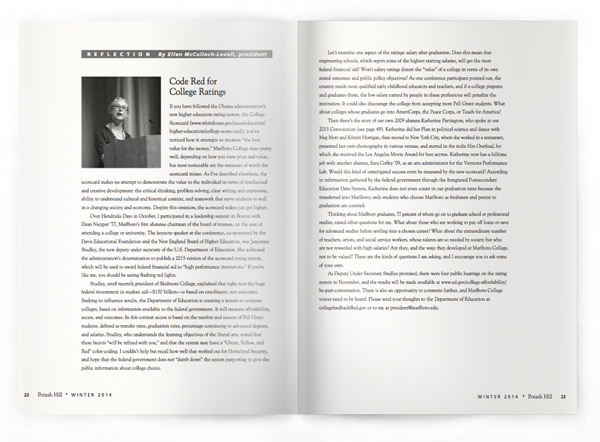Code Red for College Ratings

Reflection
By Ellen McCulloch-Lovell, president
 If you have followed the Obama administration’s new higher education rating system, the College Scorecard (www.whitehouse.gov/issues/education/higher-education/college-score-card), you’ve noticed how it attempts to measure “the best value for the money.” Marlboro College rates pretty well, depending on how you view price and value, but most noticeable are the measures of worth the scorecard misses. As I’ve described elsewhere, the scorecard makes no attempt to demonstrate the value to the individual in terms of intellectual and creative development: the critical thinking, problem solving, clear writing and expression, ability to understand cultural and historical context, and teamwork that serve students so well in a changing society and economy. Despite this omission, the scorecard stakes just got higher.
If you have followed the Obama administration’s new higher education rating system, the College Scorecard (www.whitehouse.gov/issues/education/higher-education/college-score-card), you’ve noticed how it attempts to measure “the best value for the money.” Marlboro College rates pretty well, depending on how you view price and value, but most noticeable are the measures of worth the scorecard misses. As I’ve described elsewhere, the scorecard makes no attempt to demonstrate the value to the individual in terms of intellectual and creative development: the critical thinking, problem solving, clear writing and expression, ability to understand cultural and historical context, and teamwork that serve students so well in a changing society and economy. Despite this omission, the scorecard stakes just got higher.
Over Hendricks Days in October, I participated in a leadership summit in Boston with Dean Nicyper ’77, Marlboro’s first alumnus chairman of the board of trustees, on the cost of attending a college or university. The keynote speaker at the conference, co-sponsored by the Davis Educational Foundation and the New England Board of Higher Education, was Jamienne Studley, the new deputy under secretary of the U.S. Department of Education. She addressed the administration’s determination to publish a 2015 version of the scorecard rating system, which will be used to award federal financial aid to “high performance institutions.” If you’re like me, you should be seeing flashing red lights.
Studley, until recently president of Skidmore College, explained that right now the huge federal investment in student aid—$150 billion—is based on enrollment, not outcomes. Seeking to influence results, the Department of Education is creating a system to compare colleges, based on information available to the federal government. It will measure affordability, access, and outcomes. In this context access is based on the number and success of Pell Grant students, defined as transfer rates, graduation rates, percentage continuing to advanced degrees, and salaries. Studley, who understands the learning objectives of the liberal arts, stated that these factors “will be refined with you,” and that the system may have a “Green, Yellow, and Red” color-coding. I couldn’t help but recall how well that worked out for Homeland Security, and hope that the federal government does not “dumb down” the system purporting to give the public information about college choice.
Let’s examine one aspect of the ratings: salary after graduation. Does this mean that engineering schools, which report some of the highest starting salaries, will get the most federal financial aid? Won’t salary ratings distort the “value” of a college in terms of its own stated outcomes and public policy objectives? As one conference participant pointed out, the country needs more qualified early childhood educators and teachers, and if a college prepares and graduates them, the low salary earned by people in these professions will penalize the institution. It could also discourage the college from accepting more Pell Grant students. What about colleges whose graduates go into AmeriCorps, the Peace Corps, or Teach for America?
Then there’s the story of our own 2009 alumna Katherine Partington, who spoke at our 2013 Convocation (see page 45). Katherine did her Plan in political science and dance with Meg Mott and Kristen Horrigan, then moved to New York City, where she worked in a restaurant, presented her own choreography in various venues, and starred in the indie film Overload, for which she received the Los Angeles Movie Award for best actress. Katherine now has a fulltime job with another alumna, Sara Coffey ’09, as an arts administrator for the Vermont Performance Lab. Would this kind of unmitigated success even be measured by the new scorecard? According to information gathered by the federal government through the Integrated Postsecondary Education Data System, Katherine does not even count in our graduation rates because she transferred into Marlboro; only students who choose Marlboro as freshmen and persist to graduation are counted.
Thinking about Marlboro graduates, 77 percent of whom go on to graduate school or professional studies, raised other questions for me. What about those who are working to pay off loans or save for advanced studies before settling into a chosen career? What about the extraordinary number of teachers, artists, and social service workers, whose talents are so needed by society but who are not rewarded with high salaries? Are they, and the ways they developed at Marlboro College, not to be valued? These are the kinds of questions I am asking, and I encourage you to ask some of your own.
As Deputy Under Secretary Studley promised, there were four public hearings on the rating system in November, and the results will be made available at www.ed.gov/college-affordability/be-part-conversation. There is also an opportunity to comment further, and Marlboro College voices need to be heard. Please send your thoughts to the Department of Education at collegefeedback@ed.gov or to me at president@marlboro.edu.